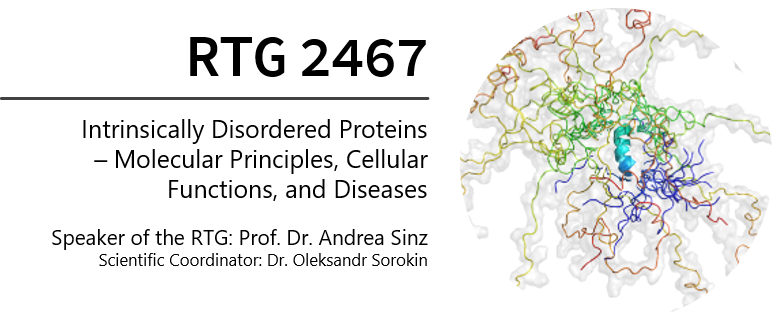
studied Biotechnology at the University of Braunschweig, Germany, where he obtained his PhD in 2000. Initially staying on as a postdoctoral research associate, he moved to the Albert-Einstein-College of Medicine, New York City, USA, in 2001 where he began to work on the role of RNA-binding proteins (RBPs) in controlling cytoplasmic mRNA fate. In 2004, he started his own research team as a junior group leader at the MLU in Halle and in 2009 he accepted a position as Associate Professor for Molecular Cell Biology. In 2010 he became the speaker of RTG 1591 “Posttranscriptional Control of Gene Expression” and in 2014 he was promoted to a Full Professor. He is also the director of the Core Facility Imaging that is located at the new Charles Tanford Protein Center. His current research focuses on the role of RBPs in cancer.
Project within the RTG
The role of the intrinsically disordered RNA-binding protein RAVER1 in cancer-derived cells
RAVER1 comprises three RRMs (RNA Recognition Motifs) and an expanded C-terminal IDR (Madl & Sattler, 2009; Hüttelmaier et al., 2001). In the nucleus, RAVER1 is enriched in membrane-less protein-RNA granules, termed perinucleolar compartments (PNC) (Norton & Huang, 2013; Hüttelmaier et al., 2001), and associates with key regulators of alternative splicing, the polypyrimidine tract-binding proteins (PTBs). RAVER1-PTB association and the regulation of splicing essentially rely on peptide motifs within RAVER1’s IDR (Rideau et al., 2006; Gromak et al., 2003). Although PNC function remains poorly understood, the abundance of PNC is associated with cancer progression and poor patient prognosis. This suggests an interconnected function of PTB, RAVER1, and PNCs in cancer. Importantly, although RAVER1 mainly resides in the nucleus, it is enriched in the cytoplasm in differentiating myoblasts and associates with adhesion proteins, e.g., VCL (Madl & Sattler, 2009; Jockusch, Hüttelmaier, & Illenberger, 2003; Hüttelmaier et al., 2001). During viral infection, RAVER1 was reported to stimulate the MDA5-triggered interferon response, indicating an involvement in the innate immune response (Chen et al., 2013). Collectively, these observations suggest multiple, presumably IDR-dependent, roles for RAVER1 in controlling protein-RNA complexes in development, infection, and cancer.
Literature references
Chen, H., Li, Y., Zhang, J., Ran, Y., Wei, J., Yang, Y., & Shu, H. B. (2013). RAVER1 is a coactivator of MDA5-mediated cellular antiviral response. Journal of Molecular Cell Biology, 5(2), 111-119.
Fink-Baldauf, I. M., Stuart, W. D., Brewington, J. J., Guo, M., & Maeda, Y. (2022). CRISPRi links COVID-19 GWAS loci to LZTFL1 and RAVER1. EBioMedicine, 75, 103806.
Gromak, N., Rideau, A., Southby, J., Scadden, A. D. J., Gooding, C., Hüttelmaier, S., … & Smith, C. W. (2003). The PTB interacting protein raver1 regulates α-tropomyosin alternative splicing. The EMBO Journal, 22(23), 6356-6364.
Hüttelmaier, S., Illenberger, S., Grosheva, I., Rüdiger, M., Singer, R. H., & Jockusch, B. M. (2001). Raver1, a dual compartment protein, is a ligand for PTB/hnRNPI and microfilament attachment proteins. The Journal of cell biology, 155(5), 775-786.
Jockusch, B. M., Hüttelmaier, S., & Illenberger, S. (2003). From the nucleus toward the cell periphery: a guided tour for mRNAs. Physiology, 18(1), 7-11.
Madl, T., & Sattler, M. (2009). Adhesion dance with raver. Structure, 17(6), 781-783.
Norton, J. T., & Huang, S. (2013). The perinucleolar compartment: RNA metabolism and cancer. Cancer Research and Treatment, 158, 139-152.
Website: https://www.medizin.uni-halle.de/einrichtungen/institute/molekulare-medizin/forschung/ag-molekulare-zellbiologie & https://www.medizin.uni-halle.de/cfi
